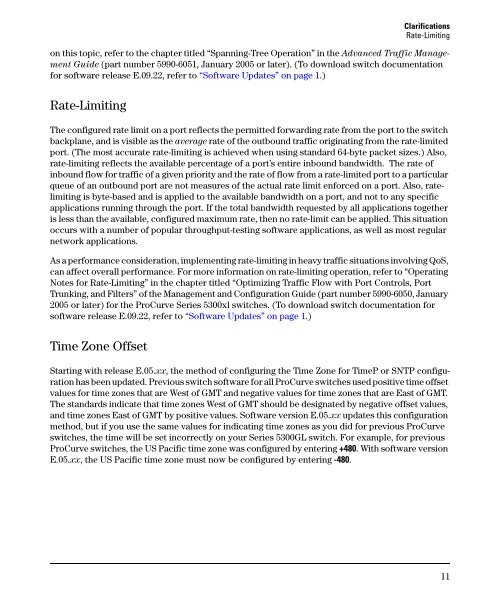Release Notes: Version E.10.37 Software
Release Notes: Version E.10.37 Software
Release Notes: Version E.10.37 Software
You also want an ePaper? Increase the reach of your titles
YUMPU automatically turns print PDFs into web optimized ePapers that Google loves.
Clarifications<br />
Rate-Limiting<br />
on this topic, refer to the chapter titled “Spanning-Tree Operation” in the Advanced Traffic Management<br />
Guide (part number 5990-6051, January 2005 or later). (To download switch documentation<br />
for software release E.09.22, refer to “<strong>Software</strong> Updates” on page 1.)<br />
Rate-Limiting<br />
The configured rate limit on a port reflects the permitted forwarding rate from the port to the switch<br />
backplane, and is visible as the average rate of the outbound traffic originating from the rate-limited<br />
port. (The most accurate rate-limiting is achieved when using standard 64-byte packet sizes.) Also,<br />
rate-limiting reflects the available percentage of a port’s entire inbound bandwidth. The rate of<br />
inbound flow for traffic of a given priority and the rate of flow from a rate-limited port to a particular<br />
queue of an outbound port are not measures of the actual rate limit enforced on a port. Also, ratelimiting<br />
is byte-based and is applied to the available bandwidth on a port, and not to any specific<br />
applications running through the port. If the total bandwidth requested by all applications together<br />
is less than the available, configured maximum rate, then no rate-limit can be applied. This situation<br />
occurs with a number of popular throughput-testing software applications, as well as most regular<br />
network applications.<br />
As a performance consideration, implementing rate-limiting in heavy traffic situations involving QoS,<br />
can affect overall performance. For more information on rate-limiting operation, refer to “Operating<br />
<strong>Notes</strong> for Rate-Limiting” in the chapter titled “Optimizing Traffic Flow with Port Controls, Port<br />
Trunking, and Filters” of the Management and Configuration Guide (part number 5990-6050, January<br />
2005 or later) for the ProCurve Series 5300xl switches. (To download switch documentation for<br />
software release E.09.22, refer to “<strong>Software</strong> Updates” on page 1.)<br />
Time Zone Offset<br />
Starting with release E.05.xx, the method of configuring the Time Zone for TimeP or SNTP configuration<br />
has been updated. Previous switch software for all ProCurve switches used positive time offset<br />
values for time zones that are West of GMT and negative values for time zones that are East of GMT.<br />
The standards indicate that time zones West of GMT should be designated by negative offset values,<br />
and time zones East of GMT by positive values. <strong>Software</strong> version E.05.xx updates this configuration<br />
method, but if you use the same values for indicating time zones as you did for previous ProCurve<br />
switches, the time will be set incorrectly on your Series 5300GL switch. For example, for previous<br />
ProCurve switches, the US Pacific time zone was configured by entering +480. With software version<br />
E.05.xx, the US Pacific time zone must now be configured by entering -480.<br />
11
















